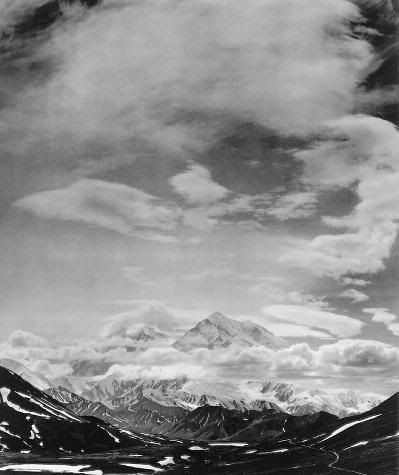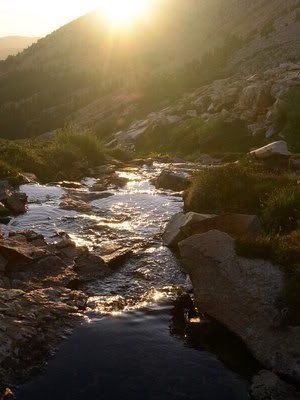
Nowadays black and white photography seems as if it has lost its popularity. Most the photographs and pieces of art that hang on the walls of homes have flamboyant coloring that seems to define the meaning of the artwork. Ansel Adams is a world renowned photographer and is known for his black and white photography. The vast majority of his photography is based out of the national parks in California and New Mexico. Ansel Easton Adams was born in 1902 and died in 1984. He originally wanted to live the life of a concert pianist and then decided to take up photography. He was an avid member of the Sierra Club and an environmentalist. He also really enjoyed hiking and that is when he did all of his photography (Wikipedia). During the course of his life Ansel was responsible for capturing many nature scenes at the height of their beauty; if it weren’t for Ansel we may not have access to such rich and pure nature photographs. Many have tried but they will never have the full capability to mimic any of Ansel’s work. Simplistic value and natural beauty were not meant be toiled with; Ansel uses his photography to demonstrate the necessity to leave nature in its state of origin.
First, we must examine the content of his photography. To the common eye Ansel is selling black and white photography that may appear to be old fashioned and serene. After analyzing Ansel and who he was, the content of his artwork is much more than the serenity that it delivers. Since Ansel was a very dedicated environmentalist and had a profound love for the outdoors, especially hiking, the underlying message becomes much more apparent. Ansel was an advocate for looking and enjoying nature but not touching or altering it in any way. By capturing unique, flawless, and breathtaking scenes on film Ansel was exuding the utmost necessity to omit human intervention and expedition (Wikipedia). If human interference could be eliminated, Ansel felt that he was upholding his duties as an environmentalist (Wikipedia).
Next, for most of the time that Ansel was a photographer the luxury of color print was not available. Once color was available he was semi opposed to its use. “I have done no color of consequence for thirty years! I have a problem with color-I cannot adjust to the limited controls of values and colors. With black and white I feel free and confident of results (Callahan 10)”. Ansel’s lack of confidence with the use of color film forced him to the continued use of black and white photography. If Ansel was uncomfortable with the results of his photography, then his true message was not able to be portrayed to its fullest extent. The complexity of color was not necessary. Ansel was a skilled, expert photographer that used his knowledge and skills to his advantage. Much like nature the unnecessary toiling was not necessary. Ansel eventually published some color photography, however, there a many fewer color prints available.

Third, even though Ansel lived from 1902 to 1984 the legacy of his photography has much out lived him. His original intention of leaving nature how it is did not die out when Ansel passed. This idea has lived on through many years, and will continue to be an integral part of life. Ansel and his photography obviously made a big impact on many people. Is his honor The Minarets Wilderness in the Inyo National

Forest was renamed the Ansel Adams National Forest in 1984 and in 1985 Mount Ansel Adams was named in Sierra, Nevada (Wikipedia). With these monumental landmarks named after Ansel we know that he made a large impact on society. The younger generations will be exposed to Ansel even though he has passed. There are many members of society today that are avid environmentalists much like Ansel. Many of these people are conducting conservation acts to preserve nature much like some of what we see in Ansel’s photography. For many people they just see Ansel’s photography as interesting and unique and don’t really understand what Ansel was trying to do with his art.
Finally, Ansel also used rhetorical appeals in his art. Both logos and ethos appeals are present. The logos appeal is presented in the fashion of rationality. Ansel was very rational in his attempt to preserve nature. It is a rational thought to want to maintain natural beauty because once it has been altered it is nearly impossible to restore. In Ansel’s case, if an entire portion of untouched land was removed to build houses, the original scenery would be irreplaceable. The ethos appeal is more directly related to ethics and credibility. Ansel was a credible source for preserving nature. Like stated before he was an active member of the Sierra club and he was an environmentalist. In his case he definitely practiced what he preached. For the ethical part of the ethos appeal Ansel was a modest thinker. He wanted people to be able to enjoy nature but don’t change or demolish it. That seems like an attainable goal.
In conclusion, it is important to examine things fully before jumping to a conclusion. I have always been fond of Ansel’s work but it didn’t have very much meaning to me. The natural beauty and the uniqueness of the black and white were attention grabbing, but I never knew what his photography stood for. Finding out the true meaning of something sheds light and knowledge on the viewer. If all things were looked at from a rhetorical perspective it would be interesting how things changed. Ansel was a respected photographer and environmentalist. His legend has stood strong for twenty three years and will continue to persevere in the future.
Works Cited
“Ansel Adams.” Wikipedia, The Free Encyclopedia. 2007. 26 April 2007. http://en.wikipedia.org/wiki/Ansel_Adams
Callahan, Harry M., Enyeart, James L., Shaefer, John P., and Stillman, Andrea G.. Ansel Adams in Color.
Boston. Little, Brown and Company. 1993.

No comments:
Post a Comment